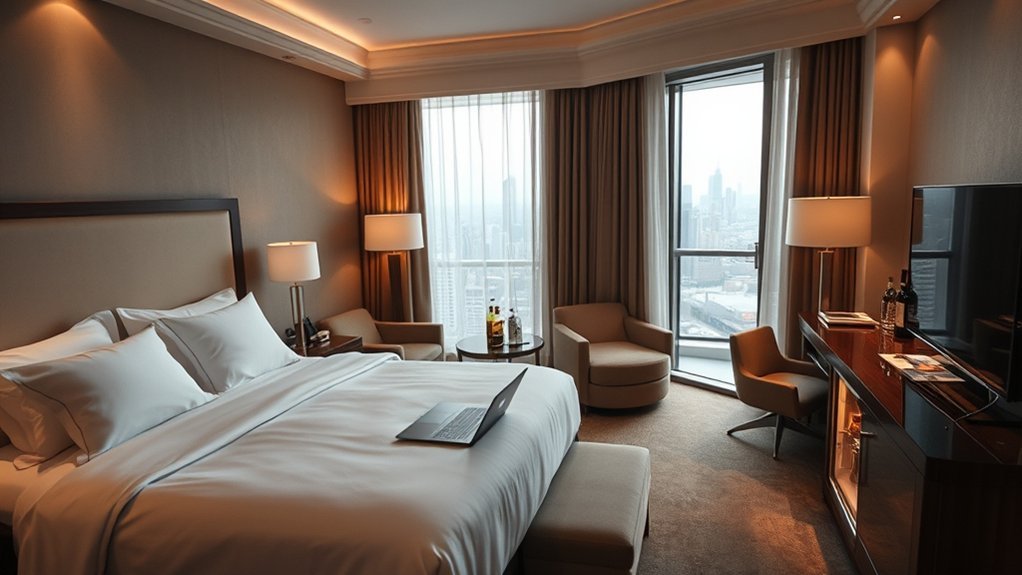When considering hotel room setup in the U.S., it is crucial to analyze the various causes and risk factors that influence design decisions. From adhering to safety regulations to enhancing guest comfort, each element plays a significant role. You’ll find that factors like room layout and furniture arrangement can directly impact the overall experience. But what happens when these considerations clash with operational practices? Exploring this dynamic reveals deeper insights into the hospitality industry.
Architectural Design and Layout Considerations
When planning the architectural design and layout of a hotel room, you must consider various factors that enhance both functionality and guest experience.
Start by analyzing the room’s size and shape; a well-proportioned space encourages movement and comfort. Position furniture to maximize usability without crowding, ensuring pathways are clear for easy navigation.
Incorporate natural light through strategically placed windows, as it considerably impacts mood and perception of space. Additionally, consider noise reduction techniques, such as soundproofing materials, to create a tranquil environment.
Finally, aesthetic elements—like color schemes and textures—should align with the hotel’s theme, influencing guests’ emotional responses. Balancing these considerations will lead to a functional, inviting hotel room that meets diverse guest needs and preferences.
Safety Regulations and Compliance Standards
Guaranteeing compliance with safety regulations and standards is essential for hotel room design, as it protects guests and staff while enhancing the overall experience.
You must adhere to local, state, and federal regulations, including fire safety codes, electrical standards, and health regulations. This includes installing smoke detectors, guaranteeing proper ventilation, and using non-toxic materials.
Regular inspections and maintenance checks are vital to identify potential hazards. Understanding accessibility standards under the Americans with Disabilities Act (ADA) guarantees that all guests can comfortably navigate the space.
Guest Experience and Comfort Factors
While safety regulations lay the groundwork for a secure environment, creating an exceptional guest experience hinges on comfort factors that cater to individual preferences and needs.
The arrangement of furnishings, choice of bedding, and control over room temperature greatly affect your overall satisfaction. Adequate lighting enhances ambiance, while soundproofing minimizes disturbances from outside or neighboring rooms.
Additionally, providing easy access to amenities, like coffee makers and charging stations, adds convenience. Personal touches, such as welcome notes or tailored recommendations, can further elevate your stay.
Understanding these elements allows hoteliers to create a more inviting and personalized atmosphere, ultimately leading to higher guest retention and satisfaction rates.
Prioritizing comfort can transform a routine visit into a memorable experience.
Operational Practices and Management Strategies
Effective operational practices and management strategies are essential for maximizing efficiency and enhancing guest satisfaction in the hospitality industry. You need to focus on streamlined processes for room setup, ensuring that staff receives thorough training on standards and expectations.
Implementing clear communication channels among departments can greatly reduce errors and improve response times. Regularly reviewing inventory and supplies helps maintain readiness without overstocking.
Additionally, establishing a feedback loop with guests allows you to identify areas for improvement, tailoring services to meet their needs. By adopting proactive management practices and fostering a culture of accountability, you create an environment that not only supports staff but also elevates the overall guest experience, leading to repeat business and positive referrals.
Impact of Technology on Room Setup
As technology continues to evolve, its impact on hotel room setup becomes increasingly significant, transforming traditional practices into more efficient and guest-centric processes.
You’ll notice that technology streamlines operations and enhances the guest experience. Here are some key aspects of this transformation:
- Smart Room Controls: Guests can adjust lighting, temperature, and entertainment systems via mobile apps or voice commands.
- Online Room Customization: Pre-arrival options allow guests to specify preferences, ensuring a personalized experience.
- Automated Inventory Management: Real-time tracking of room supplies minimizes shortages and enhances operational efficiency.
- Enhanced Communication Tools: Digital platforms facilitate seamless interaction between guests and hotel staff, improving service responsiveness.
These advancements not only elevate guest satisfaction but also optimize resource management in hotels.
Frequently Asked Questions
What Common Issues Arise During Hotel Room Setup?
Common issues during hotel room setup include improper cleaning, insufficient supplies, incorrect furniture arrangements, maintenance oversights, and inadequate communication among staff. These factors can negatively impact guest satisfaction and overall experience during their stay.
How Does Room Setup Affect Hotel Ratings?
Room setup greatly impacts hotel ratings because guests value cleanliness, functionality, and aesthetics. When you prioritize these aspects, it enhances their experience, leading to positive reviews and higher ratings, ultimately driving more bookings and revenue.
What Are the Costs Associated With Room Setup?
The costs associated with room setup include furniture purchases, decor, maintenance, and staff training. These expenses can greatly impact your hotel’s budget, influencing overall profitability and guest satisfaction if not managed effectively.
How Often Do Hotels Update Their Room Setups?
Hotels typically update their room setups every few years, depending on brand standards and guest feedback. Regular assessments guarantee they meet current trends and maintain guest satisfaction, enhancing overall experiences and encouraging repeat visits.
Are There Environmental Considerations in Room Setup?
Absolutely, you’ll find environmental considerations essential in room setups. Hotels increasingly prioritize sustainability, using energy-efficient appliances, eco-friendly materials, and water-saving fixtures, ensuring your experience aligns with modern environmental standards while minimizing their ecological footprint.
Conclusion
In conclusion, the setup of hotel rooms in the U.S. hinges on a delicate balance of safety, comfort, and operational efficiency. Did you know that nearly 70% of guests prioritize room layout and comfort when choosing accommodations? This statistic underscores the importance of thoughtful design and adherence to regulations. By focusing on these factors, hotels can enhance guest satisfaction and guarantee compliance, ultimately creating a more inviting and safe environment for all.
